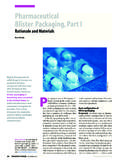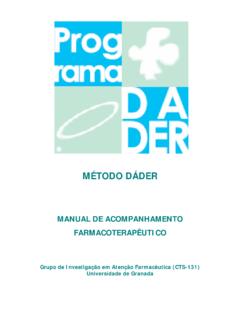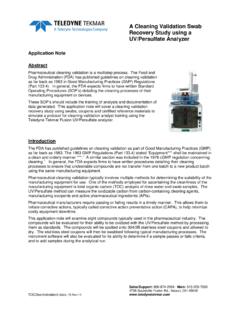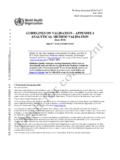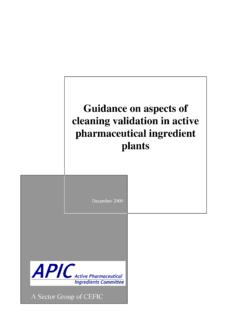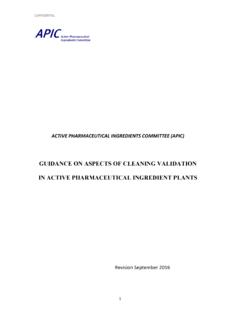Transcription of PDA Draft Technical Report No. 29 - Pharmanet
1 PDA Technical Report No. 29 Points to Consider forCleaning ValidationDRAFTM arch 30, Pharmaceutical cleaning validation Task ForceJames P. Agalloco, Agalloco & AssociatesWill Brame, Rhone-Poulenc RorerBohdan Ferenc, Novartis Pharmaceuticals E. Hall, , Hall & AssociatesKevin Jenkins, Pharmacia & Uphohn, T. LaMagna, Pfizer, E. Madsen, PDA (Chairman)Michael V. Mullen, , Eli Lilly and CompanyDietmar Wagenknecht, Fujisawa USA, M. Wagner, , Wyeth-Lederle Vaccines & PediatricsiiPrefaceThis document provides guidance relative to the validation of cleaning for a broad range of processingsystems and product types within the pharmaceutical industry. This effort commenced in 1991 inconjunction with individuals representing the biotechnology community. Early on it was agreed toseparate the development of cleaning validation guidance into "biotechnology" and "pharmaceutical"segments. The committees worked in parallel for a number of years and shared early drafts to ensurethat what would be produced by each committee would be compatible.
2 The biotech effort culminatedin PDA's 1995 publication of " cleaning and cleaning validation : A Biotechnology Perspective". The"pharmaceutical" committee continued the development of its document after the publication of thebiotech effort, and completed its stand alone guidance in the fall of goal had always been to outline cleaning validation practices across a range of equipment,process, and product applications and the inclusion of this flexibility was certainly a factor in thelength of time it took to complete this effort. During the course of assembling this document, werecognized the commonality of certain themes, issues, and concerns relative to cleaning and cleaningvalidation across the industry. We also realized that in order to apply the principles in differentoperating settings, that some narrowing of the document would be necessary. As a result, we haveincluded perspectives on the application of the guidance in various areas: finished pharmaceuticals,bulk pharmaceutical chemicals, biopharmaceuticals and clinical products.
3 Inclusion ofbiopharmaceuticals in this effort is not intended to replace the more comprehensive coverageprovided by our partner committee, but rather to provide greater insight regarding the broadapplication of the guidance provided Technical Report was disseminated in Draft for public review and comment prior to of the submitted comments have been included in the final document. We believe this approachaccomplished the widest possible review of the document and ensures its suitability as a valuableguide to industry in the area of cleaning validation . This document should be considered as a guide;it is not intended to establish any mandatory or implied E. Madsen Chairman, Pharmaceutical cleaning validation Task ForceTable of Report Pharmaceutical cleaning Use of the cleaning cleaning Program cleaning 76 Manual (CIP) 76 Clean-Out-of-Place (COP).
4 Equipment Characteristics / Materials of 76 Non-Dedicated Manufacturing 76 Non-Dedicated cleaning Contact 76 Product Contact Site 76 Critical Equipment 76 Major of Product Risk 76 High Risk Characterized 76 Poorly 76 Formulation 76 (Active or Excipient) 76 Insoluble (Active or Excipient).. Operational Product Facility 76 Multiple Product Production 76 Batch Equipment Train 76 Complex Equipment The cleaning validation Product Manufacturing Equipment cleaning Method cleaning Agent and Residue Types of cleaning Microbiological Other Contaminants to be cleaning Agent and Surface of Types of cleaning Clean-in-Place (CIP) Clean-Out-of-Place (COP) cleaning Porous Disposable Placebo Batches as a cleaning Residue Removal and cleaning Equipment Design cleaning batches of different batches of the same product (campaign).
5 Post- cleaning Equipment Monitoring cleaning cleaning Agent Product cleaning Parameter Standard Operating cleaning Operator Techniques and Analytical Sampling and Surface Visual Relationship of Analytical Method, Sampling Method, and Specific versus Non-Specific Analytical Direct Surface Total Organic Carbon (TOC).. Enzymatic (Bioluminescence).. Light Gravimetric High Performance Liquid Chromatography (HPLC).. Thin Layer Chromatography (TLC).. Capillary Zone Electrophoresis (CZE).. Fourier Transform Infrared (FTIR).. Enzyme Linked Immunosorbant Assay (ELISA).. Atomic Absorption/Ion Chromatography (AA/IC).. Ultraviolet (UV) Pass-Fail Testing Analytical Methods Microbial and Endotoxin Detection and The Scientific Rationale for Contamination of the Next Considerations for Developing Limits Based on Medical or Pharmacological Potency of the The Basis for Quantitative Limits Based on the Toxicity of the Limits Based on the Analytical The Meaning of None Detected.
6 Dividing a Limit Among Various Pieces of Verification of Verification of Monitoring of Automatic and Manual Glossary of Suggested BackgroundIn recent years, cleaning has achieved a position of increasing importance in the pharmaceuticalindustry. The current good manufacturing practices (CGMP) regulations recognize that cleaning isa critical issue to ensure product quality. Virtually every aspect of manufacturing involves cleaning ,from the initial stages of bulk production to the final dosage CGMPs in the United States, Europe and other parts of the world have provided thepharmaceutical industry with general guidance for cleaning requirements. For example, in the ,section of part 21 of the Code of Federal Regulations (CFR) states that "Equipment andutensils shall be cleaned, maintained, and sanitized at appropriate intervals to prevent malfunctionsor contamination that would alter the safety, identity, strength, quality, or purity of the drug productbeyond the official or other established requirements.
7 " Section of part 21 of the CFRidentifies that cleaning procedures must be documented appropriately, and that a cleaning and use logshould be established. In addition to CGMPs, various inspectional guideline documents publishedby the FDA contain expectations regarding cleaning in the pharmaceutical industry. cleaning is alsoaddressed in the PIC recommendations on cleaning validation and in the SFSTP Commission Report " validation des proc d s de nettoyage."It has always been the responsibility of the regulated industry and the regulatory agencies to interpretthe CGMPs and to create programs and policies which establish the general requirements as specificpractices. Recognizing the importance of the relationship between cleaning and product quality,regulatory agencies are demanding greater evidence of cleaning effectiveness through validation PurposeThe purpose of this publication is to identify and discuss the many factors involved in the design, validation , implementation and control of cleaning programs for the pharmaceutical document does not attempt to interpret CGMPs but provides guidance for establishing a cleaningvalidation program.
8 It identifies the many factors to be considered for all segments of thepharmaceutical industry. It also identifies specific points to be considered by dosage formmanufacturers, manufacturers of clinical trial materials (CTMs) and manufacturers of bulkpharmaceutical chemicals and biochemicals. The Report covers the different approaches which maybe appropriate for the different stages of product development from the early research stages to thecommercially marketed ScopeThis paper applies to biopharmaceutical, bulk pharmaceutical and finished dosage form operations;liquid, dry, solid and semi-solid dosage forms are covered in both sterile and non-sterile clinical and marketed product cleaning validation programs are manufacture of modern pharmaceuticals is a complex process involving highly technicalpersonnel, complex equipment, sophisticated facilities and complicated processes.
9 Individualsresponsible for all aspects of the production, approval and validation of products, such as qualitycontrol, quality assurance, engineering, validation , production, research and development, contractorsand vendors and regulatory affairs personnel may use this document as a resource for establishing orreviewing the cleaning programs within their validation programs described herein assume that an overall validation program with appropriatecontrols is already in place for the facility, utilities, equipment and processes. The cleaning of theenvironment is not specifically covered, however many of the same concerns that are considered forthe cleaning of process equipment also impact the cleaning of the environment. The monitoring ofmicrobiological and endotoxin contamination and steps for their elimination are mentioned in severalsections and should be part of the cleaning validation program.
10 However this document is notintended to be a comprehensive treatise on microbiological control, or endotoxin limitation. Otherdocuments have addressed microbiological programs and methods for the environmental monitoringwhich can be applied to Report OrganizationEach of the major topics of this document starts with a general section which applies to all segmentsof the pharmaceutical industry. Points to be considered for specific industry segments such asbiopharmaceuticals, bulk pharmaceutical chemicals, clinical products may vary, depending on thespecific product type. A glossary is provided at the end of the PharmaceuticalsFinished pharmaceuticals represent solid formulations, semi-solid formulations, liquid and aerosolformulations with various routes of administration. Over-the-counter and prescriptionpharmaceuticals for both human and veterinary use are included in this common characteristics shared by finished pharmaceuticals are their manufacture by combiningraw materials and active ingredients to create the final dosage manufacturers often make a large number of product types in one facility; often thereare several different strengths prepared of the same product.
